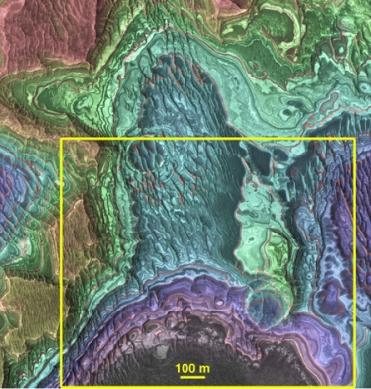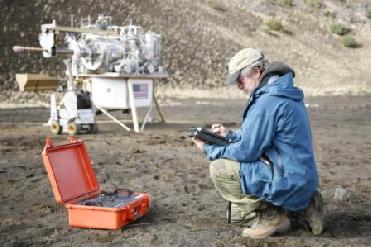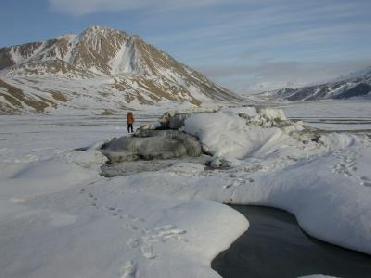
Layered deposits on Mars. Photo credit: Planetary Science Institute
WASHINGTON (BNS): Scientists searching for life on Mars should take a close look at rock varnish, for it could harbour microbial life.
In a study published in the current issue of the Journal of Geophysical Research, astronomers said that they have found bacteria associated with rock varnish in an area where the surrounding soils were essentially devoid of life.
The study, led by Kimberly R. Kuhlman of Tucson-based Planetary Science Institute, suggests that rock varnish could provide a niche habitat for microbial life on Mars and in other extraterrestrial environments devoid of liquid water.
Rock varnish is an extremely slow-growing coating that forms on the surfaces of rocks in arid and semi-arid climates. In Southwestern deserts, it often appears as a tough, dark stain on light-colored canyon walls. Ancient petroglyphs are often found etched into rock varnishes, the astronomers said.
Kuhlman's team analysed samples of rock varnish collected from the Yungay region of Chile's Atacama desert which is the closest analog to Martian environments found on Earth.
“The bacteria apparently get most if not all of their moisture from fog. The bacteria also are aerobic. So if Martian forms exist, they would have adapted to survive their planet's low-oxygen atmosphere," Kuhlman stated.
According to the study, rock varnish which consists of clay, glued together with iron and manganese oxides, forms very slowly and is very thin. It adds only 1 to 40 nanometers in thickness per year, and tends to be no more than 500 millimeters thick, regardless of age.
Similar rock coatings may exist on Mars because photos returned by every Martian Lander show what looks like rock varnish coating the rocky surfaces. However, Kuhlman cautions that these coatings might not actually be rock varnish.
"A number of different coatings, like silica, can masquerade as rock varnish. So you can't really identify it for sure until you crack it open and look at a cross section under the microscope,” Kuhlman observed.
If it is rock varnish, it could provide bacteria with the same benefit it does on Earth -- protection form ultraviolet radiation.
"Whether the bacteria help create the varnish that protects them isn't known. Some believe bacteria are involved in its formation, while others think it's abiotic. Actually, both scenarios could be true. Rock varnish could consist of layers formed by entirely different processes, depending on the prevailing environmental conditions at the time,” she said.
Since many bacteria cannot be cultivated in the lab, Kuhlman's team used culture-independent methods to identify many of the species found in the Atacama varnish. They looked for adenosine triphosphate, a molecule that provides energy for cells that is found in all living things on Earth, and they also identified DNA from 32 species, and produced live cultures of other bacteria.
Many species were related to bacteria found in air or water, suggesting that their ancestors may have been carried into the area during wetter periods and then evolved in the varnish niche as conditions changed. A similar scenario might have played out on Mars, with varnish bacteria surviving from the planet's wetter eras, the study opined.
Now Kuhlman would like to discover exactly where the bacteria live. No one knows if they are found on the surface, in the middle, at the bottom or between the varnish and the rock.
Similarly, scientists don't yet know if the bacteria are simply using the varnish for sunscreen or if they exist as a community within the varnish. The ultra-thin varnish coatings have made it difficult to answer these questions, but Kuhlman hopes to secure research grants to pursue these problems and to give planetary scientists a better understanding of how to pursue the search for Martian bacteria.
 Next Article
Next Article













The Indian Air Force, in its flight trials evaluation report submitted before the Defence Ministry l..
view articleAn insight into the Medium Multi-Role Combat Aircraft competition...
view articleSky enthusiasts can now spot the International Space Station (ISS) commanded by Indian-American astr..
view article